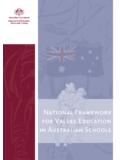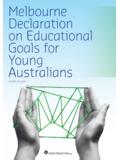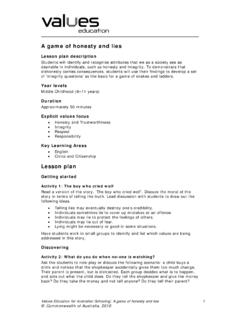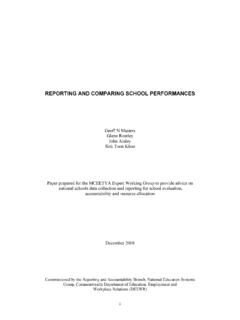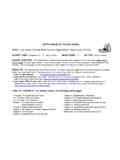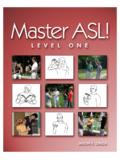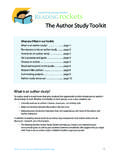Transcription of UNIT Families Past and Present: STAGE 1 TERM 3 …
1 Values in Action Schools Project: Resilience, Wellbeing and Learning: Catholic Schools of the Clarence, New South Wales 1 unit Families past and present : Stories and Histories STAGE 1 TERM 3 DURATION: 1 2 3 4 5 6 7 8 9 10 PURPOSE: Content: This unit provides opportunities for students to explore similarities and differences between their own Families and the Families of other students in their class. The unit focuses on continuity and change in different Families , looking at the value of what is retained and why changes are made, through stories told, the reasons why certain people, events and days are important to themselves and their Families .
2 It invites the students to reflect on how they show CARE AND COMPASSION, RESPECT, UNDERSTANDING, TOLERANCE AND INCLUSION towards their Families and others, just as Jesus does. Teaching For Quality Learning Purpose: Develop students awareness of the big pictures; how the various activities fit together and link to the big ideas. Values: To care for self and others. To treat others with consideration and regard, respect another person s point of view. Be aware of others and their cultures, to accept diversity within a democratic society, being included and including others.
3 AREAS OF INTEGRATION: Religion: Nourished by God English: The structure and grammatical features of the text types; Recounts, Narratives and Factual Descriptions. Maths: Graphing of people in my family. Timelines Creative and Practical Arts: Role-playing events in the lives of people, both past and present . Representing the stories people tell through music, dance, drama and visual arts. ICT: Create a digital class book of Personal Recounts. AND SPECIAL NEEDS CONSIDERATIONS: By using cooperative procedures we allow for differentiation and scaffold metacognition.
4 ASSESSMENT: Assessment tasks are noted with (A) Values in Action Schools Project: Resilience, Wellbeing and Learning: Catholic Schools of the Clarence, New South Wales 2 1. Written Recount 2. Write and illustrate a different ending to show their understanding of Care and Compassion. 3. OUTCOMES Communicates the significance of past and present people, days and events in their life, in the lives of family and community members and in other communities. Identifies and talks about the lives of people in their family and community.
5 Identifies the origins of significant days and events celebrated by their family and community. Retells the original stories associated with traditions of their family and community. Explains why a personal, family or community event is significant. Identifies changes and continuities in their own life and in the local community. Communicates the value of the contribution of past generations to community life. Describes and sequences stages and events in their life and in the lives of family members, and reflects on the significance of these stages and events.
6 Identifies customs, practices, symbols, languages and traditions of their family and of other Families . Gives information about their own family background, including languages spoken at home, religions, traditions, practices, customs, celebrations and stories Explains ways in which family members learn from each other about customs and traditions, eg recounts, songs, dances Identifies characteristics that make another family different from or similar to their own. VALUES AND ATTITUDES CARE AND COMPASSION DOING YOUR BEST FAIR GO FREEDOM HONESTY AND TRUSTWORTHINESS INTEGRITY RESPECT RESPONSIBILITY UNDERSTANDING, TOLERANCE & INCLUSION HSIE VALUES RESOURCES: GLOSSARY OF STRATEGIES Guess the Picture (A35), Inner and Outside Circle (A30), Inner and Outside Circle (A30), Brainstorm Bingo (B32), Semantic Map (B11), Think, Pair, Share (B12), Completing Questions From The Stem (B19), De Bonos Thinking Hats (C19) Retrieval Chart, Before, Before, After, After Values in Action Schools Project.
7 Resilience, Wellbeing and Learning: Catholic Schools of the Clarence, New South Wales 3 LEARNING SEQUENCE LEARNING SEQUENCE 1: Who is in my family? Weeks 1-2 Tuning In/Gathering Date & Sign on completion Guess the picture (A35) Slowly reveal a collage of photos of different family types (nuclear, extended, grandparents). Are all Families the same? Build on questions and answers. (RESPECT, UNDERSTANDING TOLERANCE & INCLUSION). Inner and Outside Circle (A30) Students take turns sharing who is in their family. Did anyone find someone with the same family make-up as their own?
8 Brainstorm Bingo (B32) In a 3x2 grid, students write/draw 6 members of their family. The first to place a counter on all family members calls out BINGO. Using the Brainstorm Bingo grid, the students cut out the family members and construct their own Semantic Map (B11) focused around the key words My Family, showing the inter-relationships of their family. Students Think, Pair, Share (B12), to identify the similarities and differences in Families . Values in Action Schools Project: Resilience, Wellbeing and Learning: Catholic Schools of the Clarence, New South Wales 4 LEARNING SEQUENCE 2: Learning About Our Families .
9 Weeks 3-4 Gathering Date & Sign on completion Introduce key concepts that students will be researching (languages spoken at home, religions, family traditions and celebrations). In small groups, children brainstorm questions that they want to ask their Families . These questions need to be based on the above topics. Each student will interview at least one family member. The teacher will collect each groups questions and construct an interview questionnaire, in a table format, that students will be able to use to interview their family members.
10 My Family Who are you interviewing? Where were you born? What languages can you speak? What is your religion? What family traditions do you have? What is your favourite family celebration? Other interesting facts With collected information from family interviews, have the students cut up their answers in order to create a whole class Semantic Map (B11) using the above concepts for each area. The purpose of this map is to show the students that within Families there are many similarities and differences which make us all unique.
